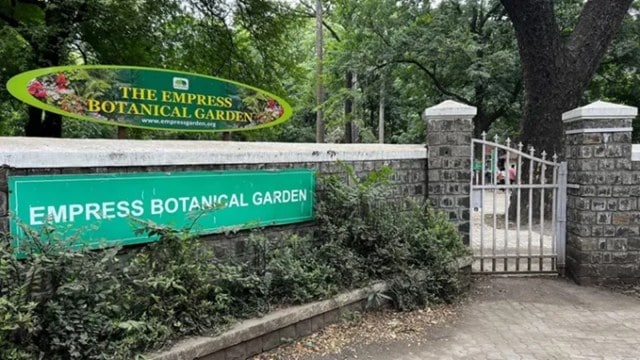Click here to join Express Pune WhatsApp channel and get a curated list of our stories
Pune’s Empress Garden conducts first systematic bird survey, records peculiar behaviours
The booklet — Birds of Empress Botanical Garden, launched on March 23 — shows that the area boasts of at least nine migratory species that visit the garden during the winter months only.
 In 1884 the Botanical Gardens, formerly situated at Ganeshkhind, were amalgamated with the Soldiers’ Gardens, and the name changed to Empress Botanical Gardens. (Express Photo by Pavan Khengre)
In 1884 the Botanical Gardens, formerly situated at Ganeshkhind, were amalgamated with the Soldiers’ Gardens, and the name changed to Empress Botanical Gardens. (Express Photo by Pavan Khengre) Spread across 39 acres, the Empress Botanical Garden is one of the green lungs of Pune but who lives there, apart from great trees? In autumn 2022, the Rupa Rahul Bajaj Centre for Environment & Art (RRBCEA), located inside Empress Botanical Garden, began to conduct a year-long sampling and survey of the birds that inhabit or visit the space.
“We are trying to do some basic biodiversity documentation of the whole place and realised that there has been no systematic documentation of the birds here. College students have come and carried out projects and there are many birders, who regularly visit the garden, but those lists are not compiled together and not available publicly. The systematic survey with proper documentation has now been put out in the form of a booklet,” said Dr Dhanashree Paranjpe, programme director at RRBCEA.
In the survey, which included birdwatchers and other volunteers and was carried out from 7-9 am during alternate months throughout the year, more than 85 species of birds were found at the gardens. “We observed many peculiar behaviours related to nesting, mating and territory marking,” said Paranjpe.
“At one point, we saw four types of flycatchers on one tree within a span of two hours and this is special because it indicates that there is a very healthy insect population in the garden and safe nesting spaces. Indian Grey Hornbills require tall trees because they nest in the hollows. So, the presence of so many Indian Grey Hornbills nesting at the Empress Garden is a sign that we have a good number of tall trees with hollow spaces as well as fruiting trees,” said Paranjpe.
The booklet — Birds of Empress Botanical Garden, launched on March 23 — shows that the area boasts of at least nine migratory species that visit the garden during the winter months only. These include the white-browed wagtail, the ashy drongo, tickel’s blue flycatcher and the beautiful black naped monarch.
During the survey, observers found that several migratory species began to arrive early as a result of climate change. While a more detailed year-to-year survey is needed, preliminary findings suggest that birds that come to the garden in November or December are now turning up in early October. “This is something that we noticed at the very beginning. It is possible that several migratory species take their cue from the temperatures of the different regions that they pass through as winters become warmer. There are also subtle behavioural changes in mating and nesting,” said Paranjpe.
Click here to join Express Pune WhatsApp channel and get a curated list of our stories













